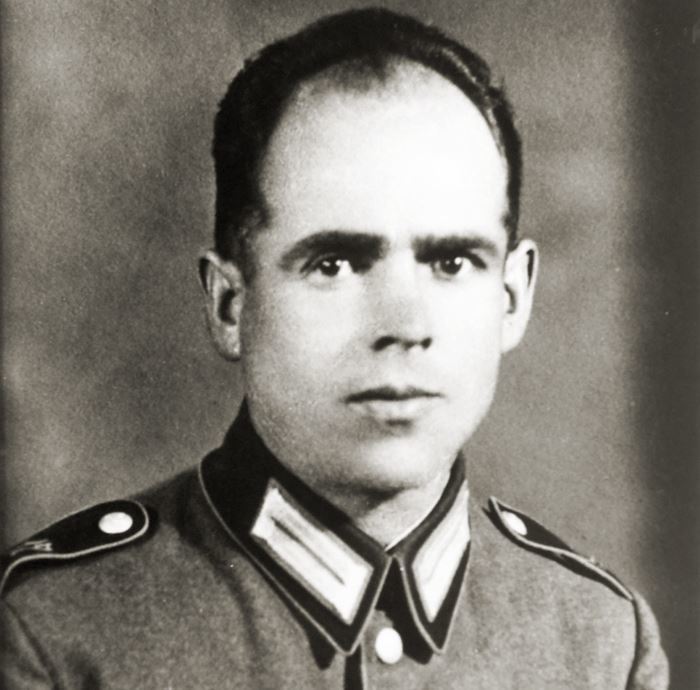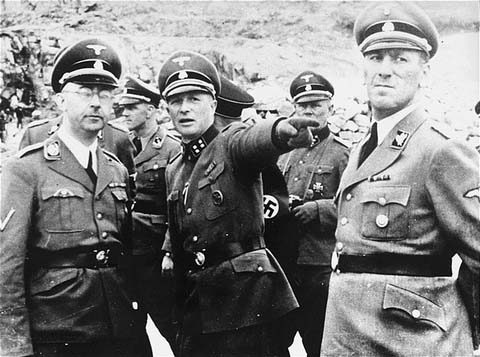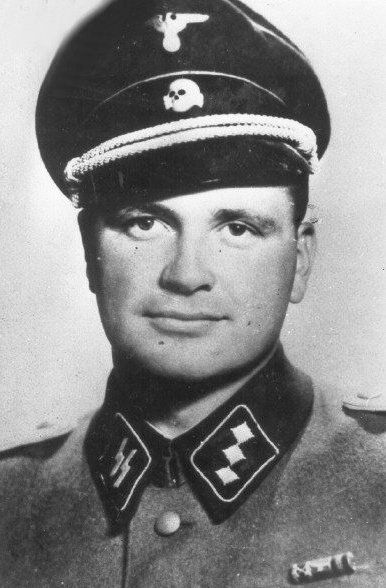|
|
Post by pjotr on Feb 13, 2020 2:59:26 GMT 1
Franz Jägerstätter  Franz Jägerstätter (also spelled Jaegerstaetter in English) (20 May 1907 – 9 August 1943) (born as Franz Huber) was an Austrian conscientious objector during World War II. Jägerstätter was sentenced to death and executed. He was later declared a martyr and beatified by the Catholic Church.en.wikipedia.org/wiki/Franz_J%C3%A4gerst%C3%A4tterA Hidden Life (2019 film) Franz Jägerstätter (also spelled Jaegerstaetter in English) (20 May 1907 – 9 August 1943) (born as Franz Huber) was an Austrian conscientious objector during World War II. Jägerstätter was sentenced to death and executed. He was later declared a martyr and beatified by the Catholic Church.en.wikipedia.org/wiki/Franz_J%C3%A4gerst%C3%A4tterA Hidden Life (2019 film) A Hidden Life (formerly titled Radegund) is a 2019 epic historical drama film written and directed by Terrence Malick, starring August Diehl, Valerie Pachner, and Matthias Schoenaerts with both Michael Nyqvist and Bruno Ganz in their final performances. The film depicts the life of Franz Jägerstätter, an Austrian farmer and devout Catholic who refused to fight for the Nazis in World War II. The film's title was taken from George Eliot's book Middlemarch. A Hidden Life (formerly titled Radegund) is a 2019 epic historical drama film written and directed by Terrence Malick, starring August Diehl, Valerie Pachner, and Matthias Schoenaerts with both Michael Nyqvist and Bruno Ganz in their final performances. The film depicts the life of Franz Jägerstätter, an Austrian farmer and devout Catholic who refused to fight for the Nazis in World War II. The film's title was taken from George Eliot's book Middlemarch.
The film had its world premiere at the Cannes Film Festival in May 2019 and was theatrically released in the United States on December 13, 2019.[6] It was the final film to be released under the Fox Searchlight Pictures name before Walt Disney Studios changed the company's name to Searchlight Pictures on January 17, 2020.en.wikipedia.org/wiki/A_Hidden_Life_(2019_film)
|
|
|
|
Post by pjotr on Feb 13, 2020 3:03:07 GMT 1
|
|
|
|
Post by pjotr on Feb 13, 2020 3:03:30 GMT 1
This is the story of an Austrian Roman Catholic who stood up against Nazism from his Christians values as a Roman Catholic. This is a story of the Roman Catholic resistance to Nazism inside the Third Reich. This was a very conscious and brave man.Austria Hitler in Vienna in March 1938Austria was overwhelmingly Catholic. At the direction of Cardinal Innitzer, the churches of Vienna pealed their bells and flew swastikas for Hitler's arrival in the city on 14 March. Cardinal Innitzer was called to Rome, where the pope rebuked him for his show of enthusiasm. Austrian bishop Alois Hudal published a book in 1937 praising the German ideal of racial unity. With power secured in Austria, the Nazis repeated their persecution of the Church and in October, a Nazi mob ransacked Innitzer's residence, after he had denounced Nazi persecution of the Church. In Britain, the Catholic Herald provided the following contemporary account on 14 October 1938: Hitler in Vienna in March 1938Austria was overwhelmingly Catholic. At the direction of Cardinal Innitzer, the churches of Vienna pealed their bells and flew swastikas for Hitler's arrival in the city on 14 March. Cardinal Innitzer was called to Rome, where the pope rebuked him for his show of enthusiasm. Austrian bishop Alois Hudal published a book in 1937 praising the German ideal of racial unity. With power secured in Austria, the Nazis repeated their persecution of the Church and in October, a Nazi mob ransacked Innitzer's residence, after he had denounced Nazi persecution of the Church. In Britain, the Catholic Herald provided the following contemporary account on 14 October 1938:
The invasion was a reply to a courageous sermon the Cardinal had preached in the Cathedral earlier in the evening, in which the Cardinal told his packed congregation that " in the last few months you have lost everything!' This sermon marked the end of Cardinal Innitzer's attempt to establish a religious peace with the Nazis. The attempt has failed. Cardinal Innitzer is now in line with his German brothers openly urging Catholics to resist anti-Catholic measures.
— Extract from Britain's Catholic Herald, Oct.
In a "Table Talk" of July 1942 discussing his problems with the Catholic Church, Hitler singles out Innitzer's early gestures of cordiality as evidence of the extreme caution with which Church diplomats must be treated: "there appeared a man who addressed me with such self-assurance and beaming countenance, just as if, throughout the whole of the Austrian Republic he had never even touched a hair of the head of any National Socialist!"
Following the Nazi annexation of Austria, many priests were arrested. The Austrian priests Jakob Gapp and Otto Neururer, both executed during the Third Reich were beatified in the 1996. Neururer was tortured and hanged at Buchenwald and Jakob Gapp was guillotined in Berlin.
The Blessed Maria Restituta, a Franciscan nun working as a nurse at the Mödling hospital was outspoken in her opposition to the new Nazi regime, and refused to remove crucifixes from her hospital walls. Arrested by the Gestapo in 1942, she was beheaded in March 1943 in Vienna.
Comment Pieter: My Polish Roman Catholic grandmother received empathic understanding from Austrian Roman Catholics. An Austrian priest even allowed them in the morning in his church to pray and have their Polish laymen service. This next to the brutal, vicious and sadistic German and Austrian Nazi's my grandmother experienced in Poland, both SS and other German Nazi organisations.Source: en.wikipedia.org/wiki/Catholic_resistance_to_Nazi_Germany
|
|
|
|
Post by pjotr on Feb 13, 2020 3:07:52 GMT 1
|
|
|
|
Post by pjotr on Feb 13, 2020 3:18:25 GMT 1
|
|
|
|
Post by Bonobo on Feb 13, 2020 22:12:55 GMT 1
This was a very conscious and brave man. [/font] [/quote] There were also others like him, but the popular belief is that Austria brought forth even more Nazis than Germany. I read a funny anecdote about Adenauer`s reaction to absurd post-war Austrian government`s demands for reperations from Germany for WW2 destruction: We`ll send them Hitler`s bones - he said. |
|
|
|
Post by pjotr on Feb 15, 2020 20:17:23 GMT 1
Bonobo,
I absoutely agree with you. I always considered Austria after the war a brown country, brown of the SA storm troopers uniform. Many high ranking nazi's and war criminals in Poland, the Netherlands and other occupied European nations were Austrians.
The 2 highest ranking Nazi's and very fanantical National socialists in the Netherlands were Arthur Seyss-Inquart and Hanns Albin Rauter.
Arthur Seyss-Inquart
Following the fall of the Low Countries in World War II, the Austrian Arthur Seyss-Inquart was appointed Reichskommissar of the occupied Netherlands. He instituted a reign of terror, with Dutch civilians subjected to forced labour and the vast majority of Dutch Jews deported and murdered.
At the Nuremberg trials, Seyss-Inquart was found guilty of war crimes and crimes against humanity, sentenced to death, and executed.
Seyss-Inquart drafted the legislative act reducing Austria to a province of Germany and signed it into law on 13 March. With Hitler's approval he became Governor (Reichsstatthalter) of the newly named Ostmark, thus becoming Hitler's personal representative in Austria. Ernst Kaltenbrunner served as chief minister and Josef Burckel as Commissioner for the Reunion of Austria (concerned with the "Jewish Question"). Seyss-Inquart also received an honorary SS rank of Gruppenführer and in May 1939 he was made a Minister without portfolio in Hitler's cabinet. Almost as soon as he took office, he ordered the confiscation of Jewish property and sent Jews to concentration camps. Late in his regime, he collaborated in the deportation of Jews from Austria.
Following the invasion of Poland, Seyss-Inquart became administrative chief for Southern Poland, but did not take up that post before the General Government was created, in which he became a deputy to the Governor General Hans Frank. He fully supported the heavy-handed policies put into effect by Frank, including persecution of Jews. He was also aware of the Abwehr's murder of Polish intellectuals. The Abwehr was the German military intelligence service for Wehrmacht during the Second World War and competitor to the Gestapo and SD (Sicherheitsdienst). Hanns Albin Rauter Hanns Albin Rauter, SS-Obergruppenführer,höhere SS- und Polizeiführer en Generalkommissar für das Sicherheitswesen in the Netherlands.Johann Baptist Albin Rauter (4 February 1895 – 24 March 1949) was a high-ranking Austrian-born SS functionary and war criminal during the Nazi era. He was the highest SS and Police Leader in the occupied Netherlands and therefore the leading security and police officer there during the period of 1940–1945. Rauter reported directly to the Nazi SS chief, Heinrich Himmler, and also to the Nazi governor of the Netherlands, Arthur Seyss-Inquart. After World War II, he was convicted in the Netherlands of crimes against humanity and executed by firing squad. Hanns Albin Rauter, SS-Obergruppenführer,höhere SS- und Polizeiführer en Generalkommissar für das Sicherheitswesen in the Netherlands.Johann Baptist Albin Rauter (4 February 1895 – 24 March 1949) was a high-ranking Austrian-born SS functionary and war criminal during the Nazi era. He was the highest SS and Police Leader in the occupied Netherlands and therefore the leading security and police officer there during the period of 1940–1945. Rauter reported directly to the Nazi SS chief, Heinrich Himmler, and also to the Nazi governor of the Netherlands, Arthur Seyss-Inquart. After World War II, he was convicted in the Netherlands of crimes against humanity and executed by firing squad.  Reichskommissar of the occupied Netherlands Arthur Seyss-Inquart on the right and Höherer SS- und Polizeiführer (HSSPF) der besetzten Niederlande Hanns Albin Rauter in the middle. The 2 Austrian Nazi's which lead the Nazi terror in the Netherlands Reichskommissar of the occupied Netherlands Arthur Seyss-Inquart on the right and Höherer SS- und Polizeiführer (HSSPF) der besetzten Niederlande Hanns Albin Rauter in the middle. The 2 Austrian Nazi's which lead the Nazi terror in the NetherlandsOther higth ranking Austrian nazi's were Ernst Kaltenbrunner (4 October 1903 – 16 October 1946), Alfred Proksch (8 March 1891 in Larischau (Czech: Láryšov; now a part of Býkov-Láryšov (German: Pickau-Larischau), nearby Jägerndorf, Austrian Silesia – 3 January 1981 in Vienna), Hermann Neubacher (24 June 1893 – 1 July 1960), Josef Leopold (18 February 1889 – 24 June 1941), and Kurt Josef Waldheim (German: [ˈkʊɐ̯t ˈvalthaɪm] (About this soundlisten); 21 December 1918 – 14 June 2007).  SS-Obergruppenführer (general) Ernst Kaltenbrunner SS-Obergruppenführer (general) Ernst Kaltenbrunner Ernst Kaltenbrunner (right) together with Reichsführer of the Schutzstaffel (Protection Squadron; SS) Heinrich Himmler in concentration camp Mauthausen. The pointing man is the German camp commander Franz Ziereis of that Austrian Nazi concentration camp. Ernst Kaltenbrunner (4 October 1903 – 16 October 1946) was an Austrian senior official of Nazi Germany during World War II. An Obergruppenführer (general) in the Schutzstaffel (SS), he held the office of Chief of the Reich Main Security Office (Reichssicherheitshauptamt; RSHA) between January 1943 and May 1945. Though Austrians made up only 8% of the population of the Third Reich, some of the most prominent Nazis were native Austrians, including Adolf Hitler, Ernst Kaltenbrunner, Arthur Seyss-Inquart, Franz Stangl, and Odilo Globocnik, as were over 13% of the SS and 40% of the staff at the Nazi extermination camps. Odilo Globocnik Odilo Globočnik (21 April 1904 – 31 May 1945) was an Austrian war criminal of Slovenian, Serbian, and Croatian descent. He was a member of the National Socialist German Worker's Party and later a high-ranking leader of the Schutzstaffel. As an associate of Adolf Eichmann, he had a leading role in Operation Reinhard, which saw the murder of over one million mostly Polish Jews during the Holocaust in Nazi extermination camps Majdanek, Treblinka, Sobibór and Bełżec. Historian Michael Allen described him as "the vilest individual in the vilest organization ever known".Franz Stangl Odilo Globočnik (21 April 1904 – 31 May 1945) was an Austrian war criminal of Slovenian, Serbian, and Croatian descent. He was a member of the National Socialist German Worker's Party and later a high-ranking leader of the Schutzstaffel. As an associate of Adolf Eichmann, he had a leading role in Operation Reinhard, which saw the murder of over one million mostly Polish Jews during the Holocaust in Nazi extermination camps Majdanek, Treblinka, Sobibór and Bełżec. Historian Michael Allen described him as "the vilest individual in the vilest organization ever known".Franz Stangl Franz Paul Stangl (German: [ˈʃtaŋl̩]; 26 March 1908 – 28 June 1971) was an Austrian-born police officer who became an employee of the T-4 Euthanasia Program ( en.wikipedia.org/wiki/Aktion_T4 ) and an SS commander in Nazi Germany. He was the commandant of the Sobibór and Treblinka extermination camps during the Operation Reinhard phase of the Holocaust. He worked for Volkswagen do Brasil and was arrested in Brazil in 1967, extradited to West Germany and tried for the mass murder of 900,000 people. In 1970, he was found guilty and sentenced to the maximum penalty, life imprisonment. He died of heart failure six months later. Franz Paul Stangl (German: [ˈʃtaŋl̩]; 26 March 1908 – 28 June 1971) was an Austrian-born police officer who became an employee of the T-4 Euthanasia Program ( en.wikipedia.org/wiki/Aktion_T4 ) and an SS commander in Nazi Germany. He was the commandant of the Sobibór and Treblinka extermination camps during the Operation Reinhard phase of the Holocaust. He worked for Volkswagen do Brasil and was arrested in Brazil in 1967, extradited to West Germany and tried for the mass murder of 900,000 people. In 1970, he was found guilty and sentenced to the maximum penalty, life imprisonment. He died of heart failure six months later.
Pieter
|
|
|
|
Post by pjotr on Feb 16, 2020 12:37:22 GMT 1
Bonobo,
I saw the movie and have to say it was a long and beautiful and heavy movie. It brought back memories of the Austrian Alps, the Swiss mountains I saw between Italy and Zürich in Switzerland, Sudety (Sudetenland) mountains in Poland, the Belgian Ardennes with the farm life of the French speaking Walloon farmers, Polish farm life and farmers in the Communist Peoples Republic, and experiences I had with mountain landscapes in France (high mountains I saw and drove over near Nice and Cannes in Southern France), The mountains of the São Miguel Island, the mountains of La Gomera, one of the Canary islands and the mountains of the Western Cape Provence in South Africa.
I couldn’t disconnect myself from the memory, emotion, feeling and fact I remember and commemorate the fact that my grandmother was in the German and Austrian lead Nazi concentration camp Mauthausen as a Polish slave labourer, that she was forced to eat grass soup and that she experienced attrocities there. During a summer train journey through Europe in 1994 I went from Belgium to Luxemburg, to France (Lyon and Nice), to Italy (Piza, Florence, Rome and Venice), Switzerland (Zürich), Denmark (Copenhagen) and Vienna in Austria. The only place I didn’t like despite the beautiful city was Vienna. It started at the train station (we came with the night train from Zùrich). The atmosphere was cold, distant, harsh (people), unfriendly, hostile and unpleasent. The rest of Europe had been fine. Switzerland was already colder, more distant, reserved and closed (the Swiss Germans of Zürich), but Vienna in my experience of a 24 year old man was unpleasent. Maybe it has to do with genes, that my slavic Polish side (50% in blood) played a role. Austrians were vicious Nazi murderers in Poland and a lot of them served in concentrationcamps or even managed concentration camps. (Franz Stangl, the Austrian commandant of the Sobibór and Treblinka extermination camps)
The mowing the grass in the movie Hidden Life brought back to me memories of mowing the grass in the Ardennes mountains for days and sometimes weeks. The farm life in Hidden Life brought me back to the farm life of the Walloon farmers in the Ardennes and the Dutch farmers in Zeeland, when I grew up in Zeeland. Maybe more modern than in the Austria of the Second World War, the movie is placed in, but that sense of farm life, the hey, the animals, the slaughtered hanging pig, the fields with the wild grass, wild flowers, wild crops, wild weeds, these mountain skies, mountain streams, brooks and rivers. The village life in which your heard sometimes that raw Austrain country dialect of the hostile farmers, who treated that family as traitors, enemies and filth. By ignoring them, throwing stones at the children of the family of Jägerstätter, and throwing hostile looks at miss Jägerstätter and the Jägerstätter family members. The tension in the movie is terrible, the discord, doubt, the pious Roman-Catholic villagers in the high Austrian mountains and that incredible view of the Austrian Alps and these mountain waterfalls.
I came out of a movie which lasted 3 hours. I can't judge Jägerstätter. Jägerstätter had his Austrian farmer mindset. His own internal issues, his ethics and values, his struggle with life in his day and time. It was a very traditional, conservative, Roman Catholic Austrian rural community he came from. Some people greated with Grüß Gott and others with Heil Hitler. The movie shows the slowly increasing influence and the infiltration of the Nazi ideology, mentality and mindset into the Austrian population. It also shows Austrians who had difficulties with the new order, because it conflicted with their traditional Austrian rural Roman Catholic way of life.
Jägerstätter was a troubled man, a conscious man, a man who did not easily made his dicision. If I can rely on the movie. Germany and Austria are the successors of Nazi Germany (the Third Reich), and therefor I understand the German and Austrian miniset of people who labeled Franz Jägerstätter as a traitor to the Austrian and German people, the soldiers and officers of the Wehrmacht who fought and died for the fatherland (the Reich) and against Bolshevism. They blamed Franz Jägerstätter for the suffering of his wife and children and not the local Nazi Austrian farmer population who bullied them, ignored them, harassed them, were agrresive to them and treated the poor woman and her children very badly. The German Bundeswhehr and the Austrian army, the Bundesheer are the follow up of the Wehrmacht and the Waffen SS, the Austrian and German Bundespolizei are the follow up of the Nazi Ordnungspolizei, the German Verfassungsschutz and the BND and the Austrian Bundesministerium für Landesverteidigung (BMLV): Federal Ministry of Defence
Abwehramt (AWA): Military Protective Office
Heeresnachrichtenamt (HNA): Army Intelligence Office
Bundesministerium für Inneres (BMI): Federal Ministry of the Interior
Bundesamt für Verfassungsschutz und Terrorismusbekämpfung (BVT): Federal Office for the Protection of the Constitution and Counter-Terrorism are the follow ups of the Abwehr, the Gestapo and the Sicherheitsdienst (SD). It is a fact that many Austrians and Germans lost their father at the Eastern Front and the Western Front. I can't disconnect that fact from their hostile reactions against Franz Jägerstätter, Fransziska Jägerstätter and their three daughters, who were little children in that time.
I thought about what I should have done if I was in the position of Franz Jägerstätter during the movie saturday evening (21:30 - 24:00) but stopped that thought experiment during the movie and just tried to see and experience what the movie showed. The different perspectives of miss Jägerstätter, Franz Jägerstätter, the mother of Franz Jägerstätter, the sister of the wife of Franz Jägerstätter, the parish priest of the community, the Austrian bisshop, the German Wehrmacht prison guards and judges.
It was hard for me to understand the mindset of Franz Jägerstätter. It is also difficult to judge Franz Jägerstätter. His wife, his mother and his children suffered a lot.
Jägerstätter was born in Sankt Radegund, Upper Austria, a small village between Salzburg and Braunau am Inn. He was the illegitimate child of Rosalia Huber, a chambermaid, and Franz Bachmeier, a farmer. As his parents could not afford a marriage, Franz was first cared for by his grandmother, Elisabeth Huber. His biological father was killed in World War I when Franz was still a child. When his mother married in 1917, Franz was adopted by her husband, Heinrich Jägerstätter.
In his youth, Franz gained a reputation for being a wild fellow, but, in general, his daily life was like that of most Austrian peasants. He worked as a farmhand and also as a miner in Eisenerz, until in 1933 he inherited the farmstead of his foster father. In that same year, he fathered an out-of-wedlock daughter, Hildegard Auer. On Maundy Thursday of 1936, he married Franziska Schwaninger (4 March 1913–16 March 2013), a deeply religious woman. After the wedding liturgy, the bridal couple proceeded on a pilgrimage to Rome. Inspired by his wife, Jägerstätter began to study the Bible and the lives of saints. The marriage produced three daughters.
When German troops moved into Austria in March 1938, Jägerstätter rejected the offered position as Radegund mayor. He was the only person in the village to vote against the Anschluss in the plebiscite of 10 April; nevertheless, the local authorities suppressed his dissent and announced unanimous approval. Although he was not involved with any political organization and did undergo one brief period of military training, he remained openly anti-Nazi. On 8 December 1940, he joined the Third Order of Saint Francis and from summer 1941 worked as a sacristan at the local parish church, being deferred from military service four times.
Drafted for the first time on 17 June 1940, Jägerstetter, aged 33, was again conscripted into the German Wehrmacht in October and completed his training at the Enns garrison. He refused to take the Hitler oath, but could return home in 1941 under an exemption as a farmer. Faced with his experiences in military service, the suppression of the church, as well as reports on the Nazi T4 "euthanasia" program, he began to examine the morality of the war. He even proceeded to Linz to discuss this with his bishop but emerged from the conversation saddened that the episcopate seemed afraid to confront the issues.
After many delays, Jägerstätter was finally called to active duty on 23 February 1943. By this time, he had three daughters with his wife, the eldest not quite six. He maintained his position against fighting for Nazi Germany and upon entering into the Wehrmacht garrison in Enns on March 1 declared his conscientious objection. His offer to serve as a paramedic was ignored. He was immediately arrested and placed in custody, first at the Linz remand prison, then from 4 May at Berlin-Tegel. A priest from his village visited him in jail and tried to talk him into serving, but did not succeed. When he heard of the fate of the Austrian priest Father Franz Reinisch, who had been executed for his refusal to take the Hitler oath, he was determined to go the same way.
Accused of Wehrkraftzersetzung (undermining of military morale), Jägerstätter was sentenced to death in a military trial at the Reichskriegsgericht in Berlin-Charlottenburg on 6 July 1943. He was deported to Brandenburg-Görden Prison on 9 August, where he was executed by guillotine in the afternoon, aged 36. After the war, in 1946, his ashes were buried at the Sankt Radegund cemetery.
Cheers,
Pieter
|
|
|
|
Post by pjotr on Feb 18, 2020 1:46:42 GMT 1
|
|